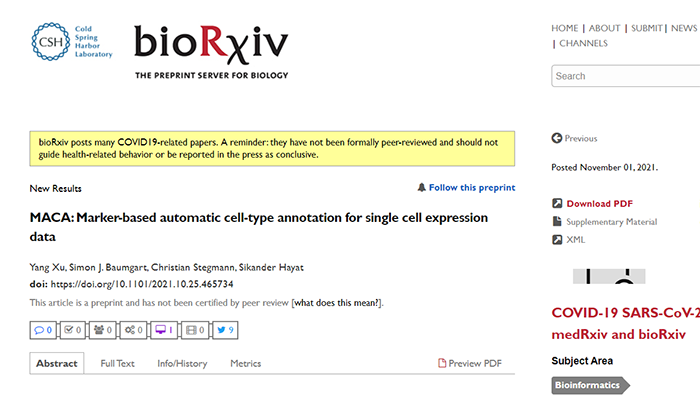前言
题目:MACA: Marker-based automatic cell-type annotation for single cell expression data
日期:2021-11
期刊:biorxiv预印本
链接:https://www.biorxiv.org/content/10.1101/2021.10.25.465734v2
GitHub:https://github.com/ImXman/MACA

设计的初衷
目前细胞类型鉴定工具中,Support Vector Machine(SVM) 的准确性超过大多数监督注释方法
“Support Vector Machine” (SVM) is a supervised machine learning algorithm that can be used for both classification or regression challenges. However, it is mostly used in classification problems.
但是,由于监督注释方法在大多数单细胞数据中缺乏真实参照,所以易用性没有非监督方法好,这也是目前非监督方法占主流的原因之一。既然使用非监督方法,那么就需要人工介入,调整分群的分辨率,以及提供marker基因,这样带来的问题就是挑选marker基因耗费时间,并且重复性差(因为每个人选择的marker基因也不同)。
基于第一个问题(挑选marker基因耗费时间),有人做了数据库,专门收录这些基因,比如PanglaoDB, CellMarker涵盖了人和小鼠多种细胞类型的marker 基因;另外NeuroExpresso是大脑组织的marker基因数据库。
这个工具MACA,全称是marker-based automatic cell-type annotation,旨在解决细胞注释的速度和准确性
设计的结构
整个设计逻辑还是很容易理解的:先判断单个细胞属于什么类型,然后聚类再判断一次属于什么类型
读入数据:single cell或者single nuclei RNA-Seq的表达矩阵
对每个细胞计算2个label:
首先,结合marker数据库,使用raw count表达矩阵,计算每个细胞的cell-type score =》 将 gene expression matrix转换成cell-type score matrix 然后,对每个细胞分配细胞类型:将score最大的细胞类型对应到这个细胞 =》 Label 1 产生 同时,利用cell-type score matrix + Louvain community detection algorithm,将细胞聚类 =》 Label 2 产生(也就是某群细胞属于什么类型)
因为一开始不知道具体有几种细胞类型,这里MACA默认将分辨率调大,避免很多同源的细胞被拆分成很多小的cluster
之后就是通过一系列统计知识,将Label1 和Label2利用起来:MACA records significant or at least the top-3 celltypes for each cell in cluster based on cell-type scores
意思就是挑出个人很能打,并且整体也很符合要求的那组

实际测试
使用的方法、数据
investigated 4 scoring methods that have been proposed to transform gene expression matrix to cell-type score matrix 2 public marker databases 6 single cell studies comprised of 3000 to 20000 cells 使用Adjusted Rand Index (ARI) and Normalized Mutual Information (NMI)进行评测
ARI & NMI are measuring similarity or agreement between our annotations and authors’ annotations
评测打分工具
发现全部6个数据集中 annotations using PlinerScore with markers in PanglaoDB have the largest agreement。于是采用PlinerScore作为打分方法
接下来和自动细胞注释工具比较
利用PanglaoDB的marker,和CellAssign, SCINA, Cell-ID, and scCATCH比较
发现速度差异:
MACA can finish annotation within 1 minute (cells around 3,000) and less than 2 minutes for a relatively large dataset (cells up to 20,000 cells) scCATCH and Cell-ID took longer than MACA SCINA took around 20-minute for a large dataset CellAssign took the longest time with > 20,000 cells due to lack of memory
发现注释结果差异:
MACA labels cells had a higher consensus than CellAssign, SCINA, Cell-ID, and scCATCH 和作者的结果相似:MACA and scCATCH identify similar numbers of cell-types to author’s annotations














